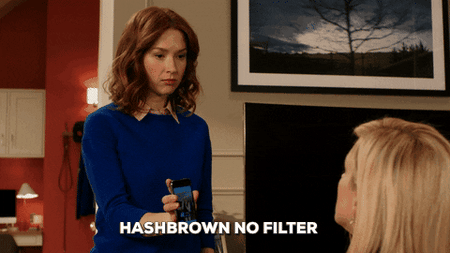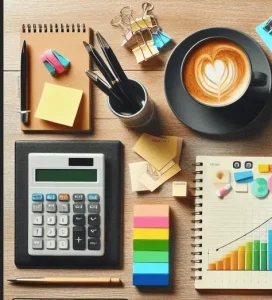How to Create a Sales Funnel That Automates Your Business
Table of Contents
The first time I tried to start a business I had no clue what a sales funnel was.
It was 2012, I’d just read an article by Tim Ferriss on how to create iPhone apps, and I was sure I could start making $10,000 per month doing the same thing.
One year later, I had two apps under my belt and a balance sheet that looked like this:
- App development cost: $2,000
- Revenue from apps: $615
- Net profit: -$1,385
It didn’t take me long to figure out the problem. Simply adding my apps to Apple’s app store and hoping people would find them hadn’t resulted in the flood of customers I thought it would.
Shocking, right? 🙂
It took two years before I was ready to try my hand at launching something again. During that time, I studied every sales funnel I could find and worked hard on building one that would make selling my next product as easy as possible.
The results? I launched an online course that generated $15,460 in total revenue within a few days.
Key takeaway: if you want your business to grow, it’s tough to find an activity with higher ROI than building a sales funnel.
In this post, I’m going to show you what most articles don’t—practical steps for actually creating and implementing a sales funnel so finding customers no longer feels like pulling teeth.
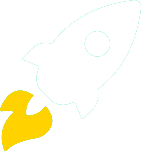
Get it Free
FREE Bonus: Sales funnels are useless without traffic. That’s why I created a 15-minute training to show you the #1 strategy for bringing 6-figure traffic to any funnel! Click the button to unlock your 24-hour pass to the training now.
Here’s everything we’re going to cover (you can click to go to a specific section if you want to skip around):
We’ll get to the juicy, tactical stuff in a second (I promise!), but before that, it’s important to understand a few high-level concepts about what a sales funnel actually is and how it works.
P.S. When we wrote this piece, our core offer was a course on how to build your list to 10,000 subscribers. But we realized that most people who bought the course weren’t taking action on what they learned. So we pivoted to a coaching program where our #1 goal is client revenue growth (we track our client wins here). If you want to learn more about why we made the switch & the best way to take action on what you learn, read this post.
Editor’s Note: This post was originally published on 12/18/17 and updated on 01/10/22.
What Is a Sales Funnel? The No-BS Definition
Look up the typical sales funnel definition and you’ll find tons of examples that sound like they’re written by marketers trying to get into Harvard Business School.
It doesn’t have to be that complicated. Here’s my simple, no-BS definition:
A sales funnel is a system for turning regular ol’ people into raving fans who can’t wait to buy your product.
When I was trying to sell my iPhone apps, I had no system for capturing attention and making people fall in love with my products. It was like shouting into a void:
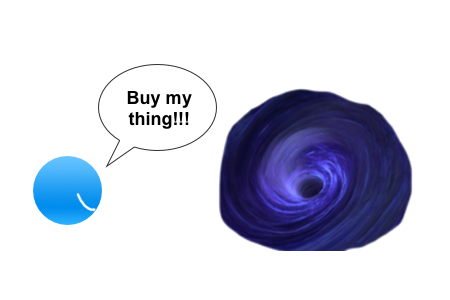
Selling my course was a different story. Thanks to the sales funnel I built, it looked like this:
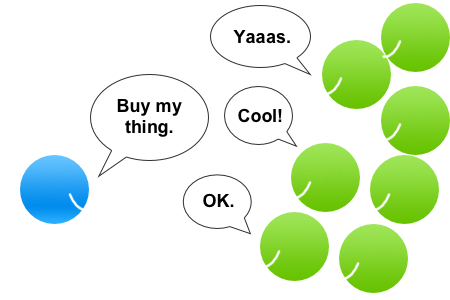
By the time I was closing sales, every single one of those people had been through a series of stages designed to qualify them as prospects and warm them up to the sale. Let’s talk about those.
The Sales Funnel Stages That Turn Random Strangers into Customers
Do a Google image search for “sales funnel” and you’ll get a bunch of customer journey diagrams like this:
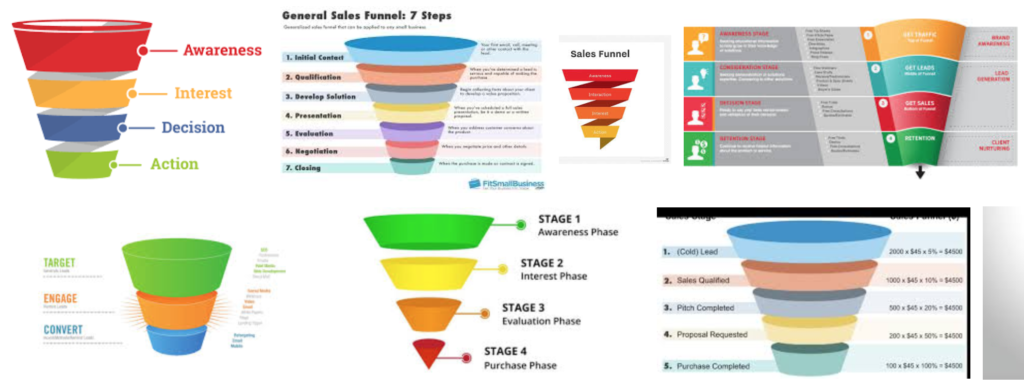
Most of these make sense—your funnel starts by generating awareness for your product (or the problem it solves), then captures leads who are interested in a solution, guides them toward making a purchasing decision, and finally allows them to take action and buy. Awareness, Interest, Desire, Action: AIDA.
By itself, AIDA is a little hard to take action on. So let’s take a look at what you actually need to build at each stage in order to move people from one stage to the next.
Stage #1: Creating Awareness
Think of the awareness stage as the point where people first hear about your business or product. This usually happens when:
- Another website links to you
- Your business shows up in a search result on Google
- People see an advertisement you create
- Someone mentions you on a podcast
- A happy client tells other people how much they loved working with you
The bottom line is that awareness happens when you get your stuff in front of people in places where they hang out.
Stage #2: Capturing Interest
Once people become aware of your business, they have the option to express interest. That might mean:
- Clicking on a link to your website from one of their favorite blogs
- Clicking an ad in their Facebook feed
- Checking out your Twitter page after someone retweets you
- Looking up your website after a friend tells them about it
Once someone enters the Interest stage, your #1 goal should be to capture that interest by getting them to sign up for your email list.
That way, you have the ability to contact them in the future and continue nudging them through your funnel.
Stage #3: Guiding Interested Prospects to a Make a Buying Decision
In Stage 3, your goal is to present prospective customers with a compelling offer that makes them decide whether they will become a customer or not.
Basically, this is your sales process, and there are tons of different ways to get here. You might:
- Send them a series of emails designed to warm them up to the sale
- Send them to a long-form sales page that taps into their emotional needs and explains the benefits of your product
- Get them to register for a webinar where you pitch your product
- Get them to book a phone call where you pitch your services
In the templates section below, you’ll see a variety of these methods.
Stage #4: Creating Action and Closing the Sale
The Action stage happens once someone decides to purchase your product.
Think of it as the purchasing experience—the checkout page, ordering process, shopping cart, booking form, etc.
In each sales funnel stage, you should have two goals:
- Identify the people who are ready to move to the next stage (and convince them to do so)
- Identify the people who are not ready to move to the next stage, so you can continue nurturing them until they are ready
Alright, now let’s get down to the nuts and bolts.
3 Questions You Must Answer Before Building Your Sales Funnel
Before you start thinking about what you’ll need to create for each of the sales funnel stages, it’s important to answer 3 questions:
- What will my funnel sell?
- What’s the best way to sell that product?
- Where will my funnel get qualified traffic from?
There is basically an infinite number of things you can combine to create your funnel. Getting crystal clear on answers to these questions will help you dramatically simplify the process of figuring out what yours needs.
Let’s start with Question #1.
#1: What Will My Funnel Sell?
For some, the answer to this question will be obvious. You have one product, you know people like it, you just want to sell more of it.
If that’s the case, awesome! Skip ahead to Question #2.
BUT…if you sell more than one product (or offer more than one service), it’s important to figure out exactly what you want your funnel to sell.
For example, if you’re a web designer, don’t just create a funnel built around a vague idea like “selling web design.” Build a funnel designed to sell a specific service you offer. Ask yourself questions like:
- What’s my most popular service?
- Which service do I enjoy doing the most?
- Which service usually leads to lots of future work?
- Which service is the easiest for me to sell to people?
If you’re selling a product instead of a service the questions might look like:
- What’s my most popular product?
- Which product usually leads to future purchases?
- Which product is the easiest to sell?
- Which products have the best margins?
For most businesses, your sales funnel should be designed to sell one thing. However, there are exceptions.
It probably wouldn’t make much sense, for example, for an online clothing store that sells 300 different products to make a sales funnel for each individual item. But it would make sense to make one for a certain category of items.
Designing a sales funnel to sell more superhero t-shirts would be much easier (and likely more effective) than designing one to achieve a vague outcome like “sell more clothes.”
Get specific!
#2: What’s the Best Way to Sell My Product?
Every sales funnel builds up to a pitch, but that pitch can happen in a variety of different places/formats.
- If you run an eCommerce store that sells t-shirts, the answer is probably pretty easy—people buy the shirt on the product pages in your online store.
- If you sell high-end coaching services, you probably have the easiest time convincing people to buy in a high-touch setting like a phone call or a webinar.
- If you sell software, people probably buy most frequently from your pricing page.
- If you sell a course, a long-form sales page might be the way to go.
Once you know the answer, the objective for your funnel becomes a little more clear: get qualified new leads to reach that sales mechanism.
Which brings us to Question #3.
#3: Where Will My Funnel Get Qualified Traffic From?
When most people think about building their first funnel, they start thinking they have to go out and find a bunch of new traffic for it.
Wrong! The best thing you can do is start with the traffic you already have.
Do you already have a website? Is it getting traffic? (It’s okay if it’s only a little bit.)
Congrats! You already have people in the Interest stage of your funnel: your website visitors. And congrats again if you’ve already gotten some of them to sign up for your email list—those interested prospects will be even better leads.
The best thing you can do is start building a funnel that will capture those prospective customers and move them along to the next stage.
When you’re first getting into building sales funnels, I almost always recommend starting with existing traffic sources like this. It’s the easiest way to get started and learn the process.
Think of your traffic options this way:
- Existing web traffic
- Email list subscribers
- New traffic you get organically through lead generation methods like SEO, guest posting, social media, etc.
- Traffic you buy with ads
- Traffic you get from partners (getting in front of other people’s audiences)
There are more methods for finding qualified traffic for your funnel, but these are the main ones we’re going to discuss in the rest of this post.
Below, you’ll find 6 proven sales funnel templates that I’ve divided by traffic source. If you have existing traffic, check out templates 1 and 2, for example.
Want to skyrocket your revenue in the next 90 days? Schedule a complimentary call with one of our certified coaches and we’ll look under the hood of your business.
6 Proven Sales Funnel Templates & Case Studies You Can Copy
Raise your hand if you have ever overcomplicated something?
*raising my hand*
Not too long ago, I was banging my head against the wall for 3 weeks straight trying to get a membership site for Videofruit completed.
I was super pumped about it, but the technology side of it was a massive pain in the butt.
After spending more than 3 weeks trying to get the dumb thing up and running, I took a step back and asked myself:
“Self, how can you simplify this?”
..
.
EPIPHANY!!
.
..
Instead of trying to go super fancy in the beginning I decided to make the entire membership site one page…
- I couldn’t figure out the payment system. So I made it free.
- I couldn’t figure out a caching plugin conflict. So I disabled it.
- I couldn’t decide on a design for my subpages. So I got rid of the subpages.
A couple hours after I made those decisions, the site was nearly done.
After 21 days of working on the site I had barely made progress. After simplifying, it was ready to go the next day.
I would make it more fancy later. For now, simple.
Complicated has its place, but mostly it’s just a form of procrastination.
Sales funnels are the same way. You can make them infinitely complex.
- Upsells
- Downsells
- Cross sells
- Drip campaigns
Or, you could just ask your customer to buy your product!
Sometimes, you just need to simplify.
That’s why I want to show you a good mix of both simple and more complicated sales funnel templates below. I’ve rated the degree of difficulty of each one on a scale of 1 to 5, with 5 being the most difficult/time-intensive.
I’ve also included some prerequisites you should have before implementing each one.
Template 1: Buffer’s 2-Step Sales Funnel
Degree of Difficulty: 1 out of 5
Traffic Source: Any existing traffic your website is getting
Buffer is a social media scheduling/calendar software tool with a popular blog that gets just over 750,000 readers each month.
They have a very simple call to action on the sidebar of their blog. In fact, it’s the only thing on the sidebar at all.
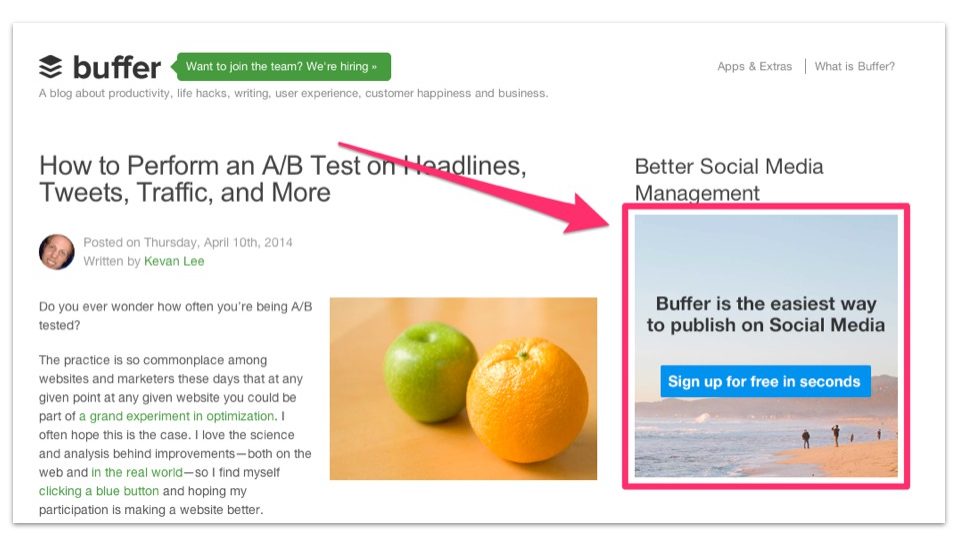
It is also a sticky widget. So as you scroll down the page it goes with you. The call to action (CTA) is plain and easy to understand: TRY. OUR. PRODUCT.
By the time someone has clicked on a link to their blog, they’ve already moved from the Awareness stage to the Interest stage. The sidebar widget captures that interest and moves them straight to the the Decision stage:
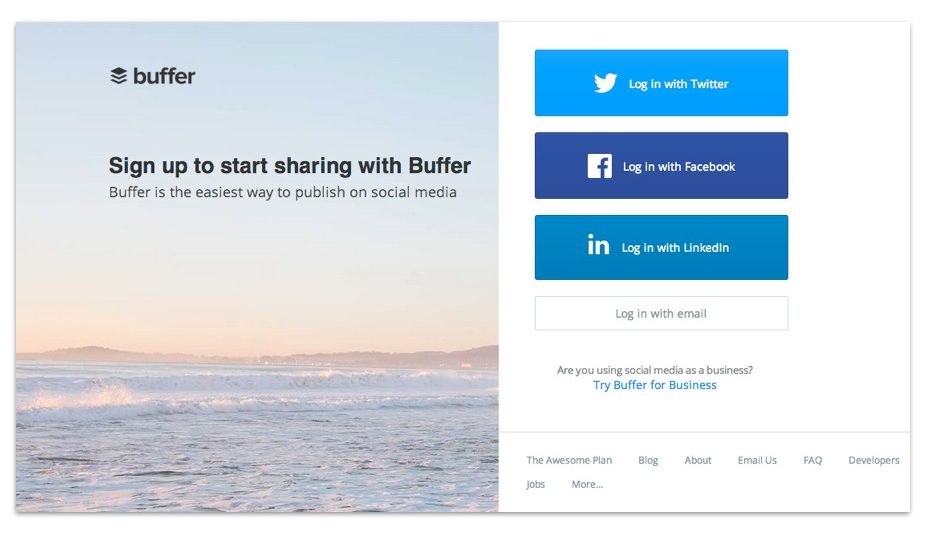
When you click through the blog widget you are sent directly to a signup page. No drip email marketing campaign or free download. Just their product. Nice and simple.
Tips: I would recommend that you make sure the language on the landing page directly coincides with the call to action that the user originated from. In this example, it is slightly confusing.
The user clicks a link to “Sign up” but the landing page asks them to “Log In.”
The basic formula here is incredibly simple and you can apply it in many different ways. Buffer does two things:
- Creates content that attracts people interested in digital marketing
- Gives them a clear, simple call to action
If you want to create a sales funnel for a low-cost product, this formula can work really well. Since the price is low, people don’t need an email sequence or lengthy sales pitch to convert them into new customers. The product just needs to be relevant to the people whose interest you captured with your content.
- Identify the pages on your website that are already getting steady traffic. This is as simple as opening Google Analytics and going to Behavior > Site Content > Landing Pages.
- Place a call to action for your product on that page.
- Create a simple page that allows people to sign up for or purchase that product.
Expected Results:
In the past, we’ve seen email signup forms in the sidebar of our blog convert at around 10%. Since signing up for a Buffer account is free, it’s fair to think they might have achieved a similar conversion rate.
However, if you want to direct visitors to a paid product from the sidebar, you can probably expect a lower conversion rate. If you have an existing sales page, start by seeing what the current conversion rate is.
By adding a sidebar link to that page, you’re essentially just sending it more warm traffic, so it’s not unreasonable to assume the conversion rate would stay similar (depending on its current primary sources of traffic).
Template 2: The Content Upgrade Funnel
Degree of Difficulty: 2 out of 5
Traffic Source: Your blog
Ever seen a lead magnet offered at the bottom of a blog post?
It usually goes like this:
Someone reads your blog post, enjoys it, and is offered a high-quality downloadable resource in exchange for their email address. It’s a nice way to use a blog to grow your email list. But it’s not the best way.
A content upgrade is this strategy on steroids.
Instead of offering the same generic lead magnet on every blog post, a content upgrade is a lead magnet you create specifically for one blog post, and it’s 100% related to the topic and pain points of that post.
Since content upgrades are much more relevant to the content of the posts they’re on than generic lead magnets, they convert at a much higher rate. Some people have even seen increased conversions as high as 785% when they implement content upgrades.
This makes them an ideal source of qualified traffic for any of your sales funnels. You can easily send anyone who opts in for one of your content upgrades to an email series that sells them a product, gets them to register for a webinar, prompts them to sign up for a demo, or asks them to take any other kind of action that will move them deeper into your funnel.
One of the most powerful things you can do, however, is simply get them to take action on the thank you page they see after signing up for your content upgrade. That’s what I’m going to show you in this marketing funnel from Jerry Jenkins, a bestselling author who sells online courses and a membership community where he teaches writing.
Anyone who reads his blog post on how to write a book is offered a content upgrade giving them a free PDF version of the post. The call to action looks like this:

When you click the link, an opt in form appears so he can capture your email address:
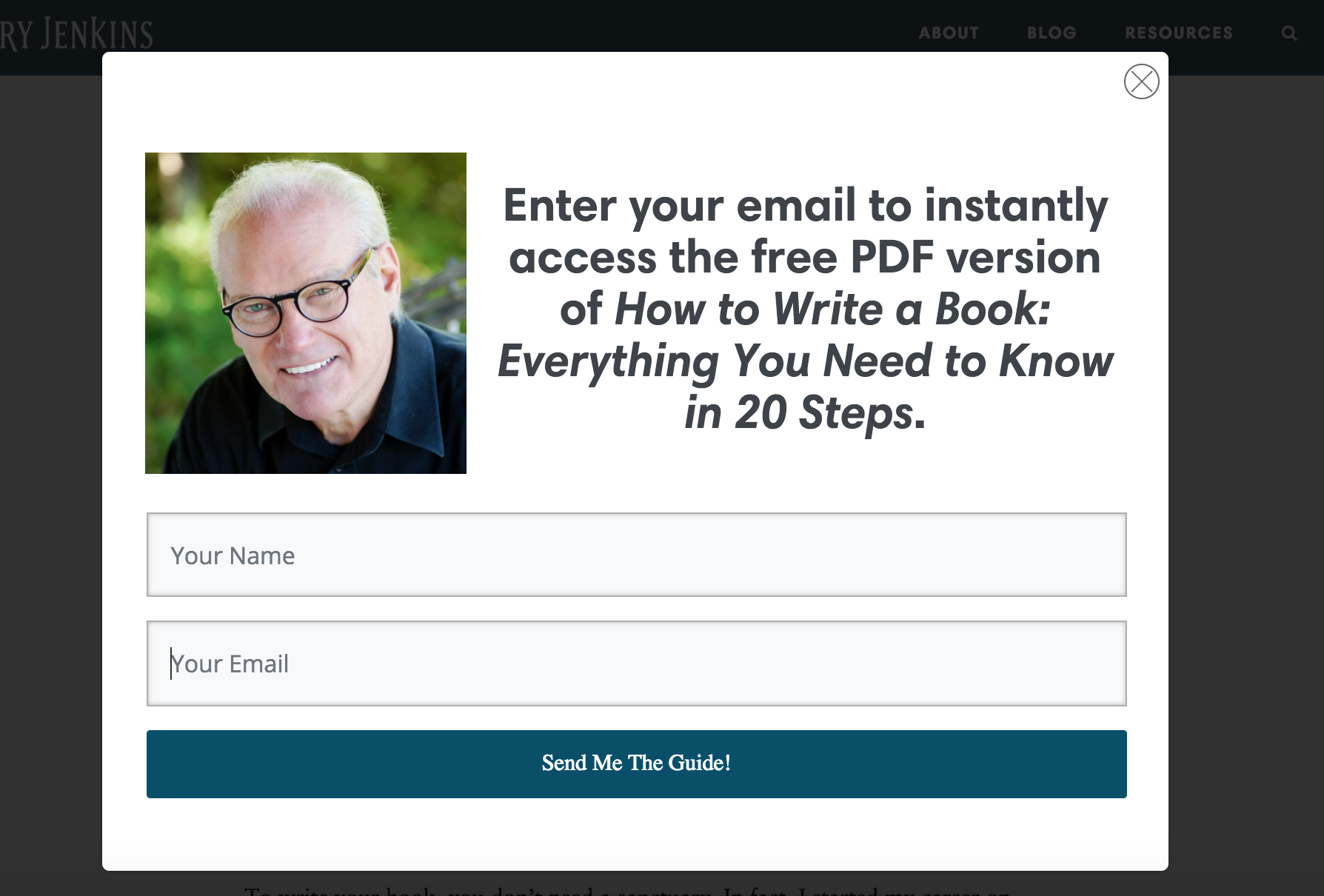
After you sign up, the magic happens. The PDF is delivered via email, but you also land on a thank you page that has a special $1 trial offer for his membership site. Check it out:

Think about it—since the post is long, anyone who reads it is going to be interested in opting in for the content upgrade so they can save and access it later.
And anyone who is that serious about writing a book is likely to be interested in an online community where a bestselling author teaches them how to write.
The fact that they can try the community and mingle with his current customers for just $1 is icing on the cake.
This type of content upgrade funnel is perfect for getting one of your products in front of highly qualified traffic quickly. And there are tons of ways you could customize this template to fit your business/product.
For example, if the product you want to offer is higher priced, you might add a video to the thank you page that explains the benefits a little more in depth.
Or, you could turn the thank you page into a registration page for a webinar where you sell the product.
Or, you could simply add anyone who signs up for the content upgrade to a series of emails that warm them up to your offer before you pitch it (you’ll see a great email sequence to copy in the next template).
- Identify the blog posts that are getting the most traffic. This is as simple as opening Google Analytics and going to Behavior > Site Content > Landing Pages.
- Create a content upgrade for that blog post. Check out this post for ideas and templates. You can even offer a mini email course.
- Add a call to action and opt-in form for the content upgrade on your post.
- Create a thank you page that moves subscribers to the next stage of your funnel.
Expected Results:
In the six weeks after Jerry’s team implemented this sales funnel, 5.88% of visitors to the blog post opted in for the content upgrade, and 2.5% of those people purchased a $1 trial on the thank you page.
Remember though, that’s around what you could expect before installing extra elements to this sales funnel. For example, you could put everyone who didn’t purchase the trial into an email sequence that adds more value and then offers it again.
Or, you could email them an invitation to a webinar that sells them on the trial.
Still, you can see the power of simply adding two more steps to the usual opt-in process and turning it into a basic sales funnel: dozens of new sales coming in automatically every week.
Template 3: Nathan Barry’s Email Campaign Funnel
Degree of Difficulty: 3 out of 5
Traffic Source: Your email list
Whether you know it or not, if you have an email list, you already have the first half of a fully functional sales funnel.
Think about it: every subscriber on your list is some who…
- Became aware of your business
- Expressed interest in something you’re doing by signing up for your list
Some of them are already loyal customers. The only thing left for you to do is turn that interest into sales with a rock-solid email marketing strategy.
Enter Nathan Barry.
Before he founded the popular email marketing SaaS platform ConvertKit, Nathan was a designer and author. He had around 18,000 email subscribers and 3 flagship products: Authority, Designing Web Applications, and App Design Handbook.
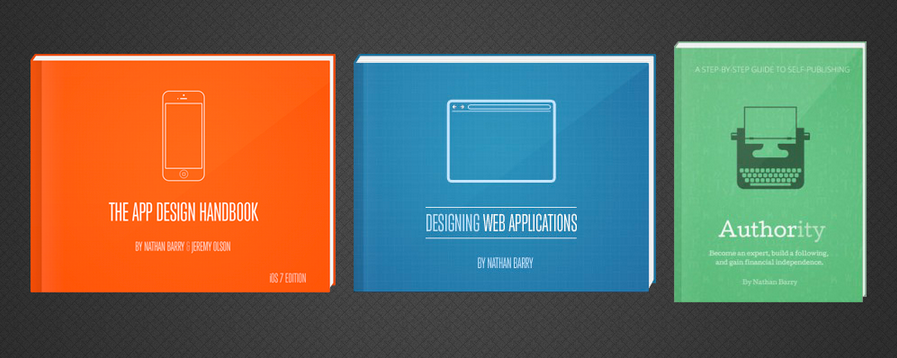
Eventually, he decided to create a secondary product called Building Profitable Audiences (BPA). It was a premium product priced at $699 and $2,499.
How would you go about selling a new product like this to your audience?
Many people (including myself) would do something like this:
- Build awesome product
- Email all 18,000 people to tell them about it
- Wait for sales
Nathan took a different approach. He saw BPA as a second-tiered product and used segmentation so only existing customers who had bought his introductory product, Authority, would receive an email sequence that sold them BPA. He knew those folks were the ideal customers for his new product.
Why do this?
Think about it. If I emailed you tomorrow and asked you to buy a $2,000 Mastermind session (second-tier product) with me, and you had never bought anything from me in the past, would you buy?
Probably not.
However, if you were a current coaching client (first-tier product) who already paid $500 per month, and I introduced a $2,000 Mastermind session to you, would you buy then?
Probably so.
Tier 1: Coaching @ $500
Tier 2: Mastermind @ $2,000
(Note: I don’t have a Mastermind to sell you. This is make-believe.)
Soooo….If my #1 goal this month is to fill up my Mastermind group, what should be my primary focus each day?
Yup! Selling more coaching.
Take a look.
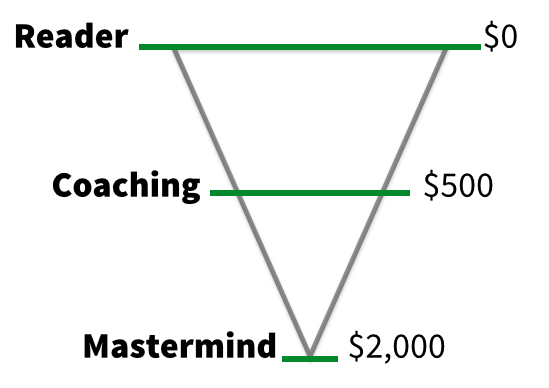
To positively affect the bottom of the funnel (BOFU) we have to focus on the top of the funnel (TOFU). Then you can move your TOFU prospects to the middle of the funnel and on down.
So, instead of Nathan emailing his entire list about a BOFU product, he only focused on past customers who had purchased his book, Authority.
It’s a natural progression of products.
Make sense?
This is what his sales funnel looks like.
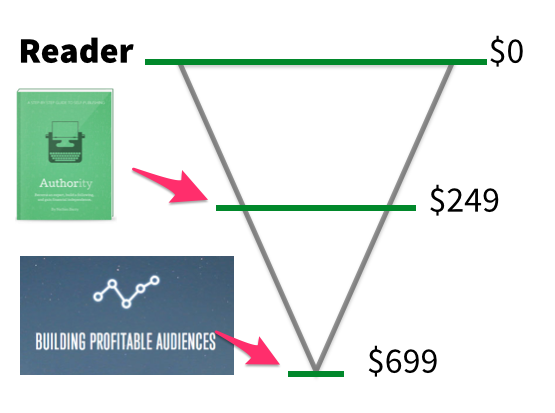
Following this philosophy, he launched his product to only 1,200 of his 18,000 subscribers…
…and out of those 1,200 people came $16,000.
Not a bad day at the office for ole Nathan.
Now, the question is…how do you take the subscribers who you know would be interested in your product and convert them into actual customers?
With an email sequence. Let’s take a look at the successful emails Nathan used.
Nathan’s Email Sequence for BPA
An email sequence is just a series of emails designed to warm up subscribers to your product and then convert them into customers.
First, let’s take a look at the overall structure of the campaign.
In total there are 6 emails.
The first two emails are long-form educational emails. They are designed to build up intrigue and to re-establish Nathan as an authority on his subject.
The third email is a product description. It is designed to tell readers about the product, describe the outcomes they can expect, and to let them know it will be available for sale tomorrow.
The fourth email is the launch email. Short and to the point.
The fifth email is another long-form educational email that comes on day 2 of the 3-day launch window. This email is designed to solidify Nathan’s authority on the topic and create a knowledge gap that ends with a strong call to action to buy the product.
The sixth, and final, email is the urgency email. It informs the reader that registration to the course will end in 1 hour.
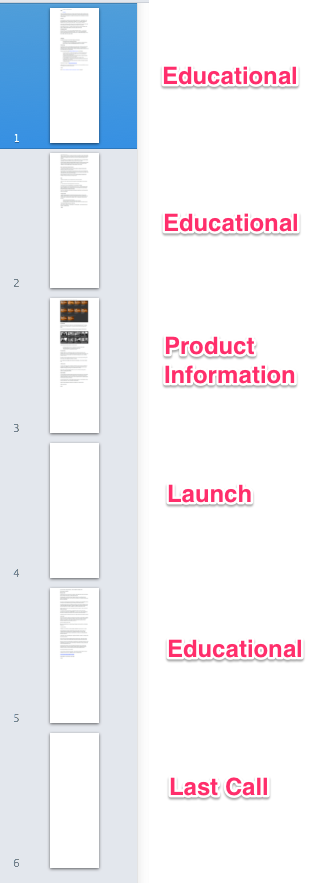
Now let’s take a peek at each email and go over the details.
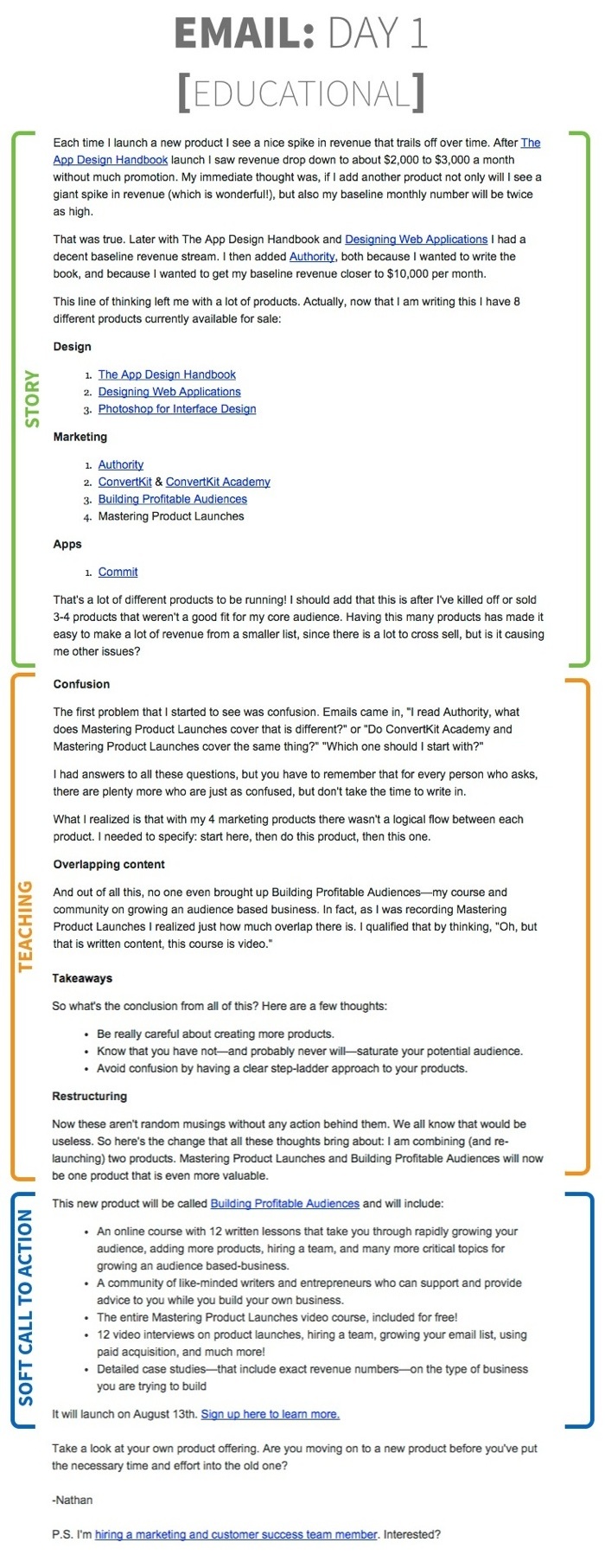
Part 1: Story. The email opens with a story that sets up the educational content.
Part 2: Education. The meat of the email teaches. That is the primary purpose of the email and what he spends the most words on.
Part 3: Soft Call to Action. Notice the word SOFT. Nathan does not ask you to buy anything. He informs readers about the product, then gives a way to learn more.
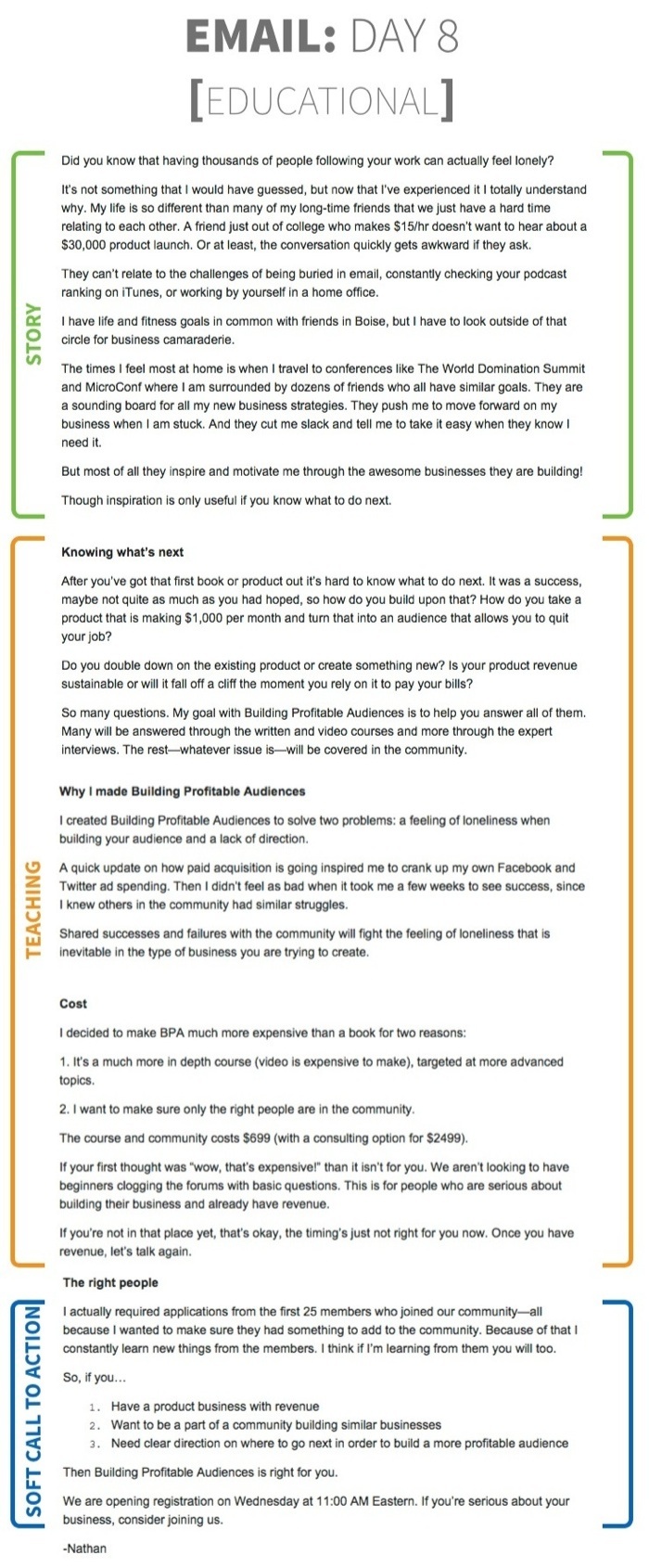
Nathan uses something called the “Reluctant Hero” to frame the entire email. The story told and teaching given is about the story of the product, why it was created, and the results achieved.
This approach drew me in and helped me connect with Nathan and the product.
What do you think sells more effectively? Hyping your product OR telling the story behind why you made it and what pains it solved for you?
Use that to your advantage.

The sub-headers are all benefit-focused and each section hits the highlights of the course.
The end of this email is vitally important. It lets readers know two things:
- That BPA will be available for sale tomorrow
- That it will only be available for 3 days (then you can’t buy it)
The last part gives readers a sense of urgency and encourages them to take action.
Life is busy. Stuff happens. I can read your blog posts whenever I want. So, I don’t read them now.
But if you tell me a product I’m very interested in is only available for 3 days, I take action.
Urgency = Action Taking.
Make sure you provide an element of urgency in this 3rd email.
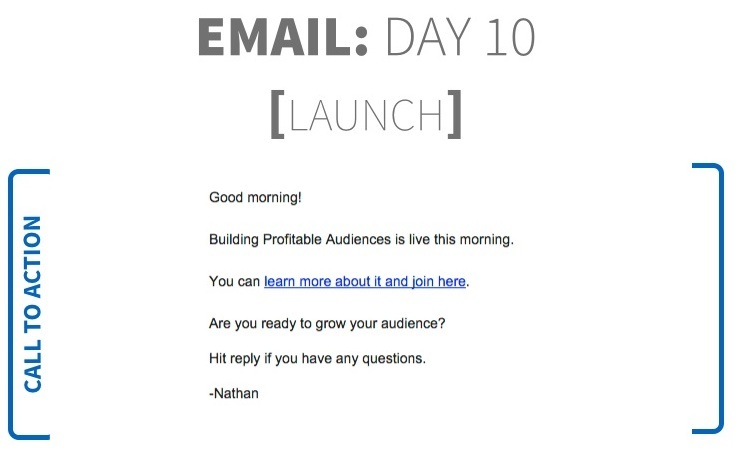
- Read Nathan’s blog
- Bought his book, Authority
- If they have implemented anything they have learned, they have seen results from his teaching
- Just received 2 really long and quality articles helping them build on what they learned in the book
- Been introduced to a new product that will take that learning to the next level.
The hard work has been done.
Now, the product is available and ready to buy. He keeps the email short and to the point.
The singular purpose of the email is to get readers to buy.
The 3-day launch window is now opened.
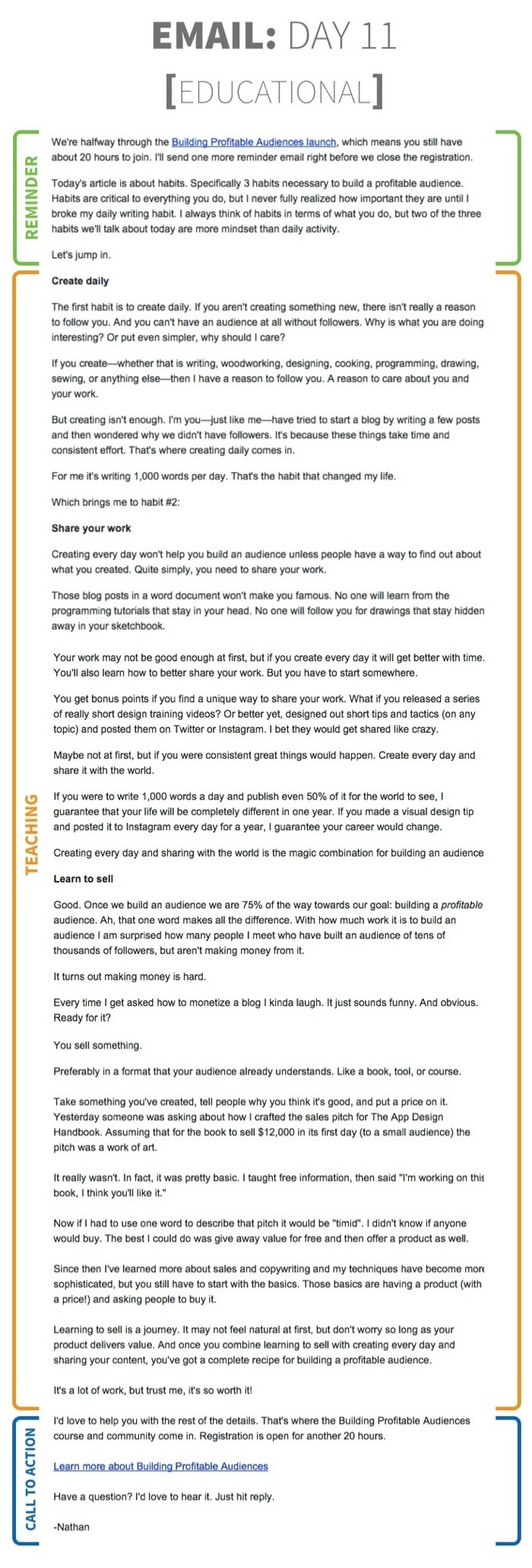
Day 2 arrives with this email. Educational email #3. Very deep and high-quality material.
This is the final push his readers need.
“If his free content is this good, the paid stuff must be incredible!”
<click. buy>
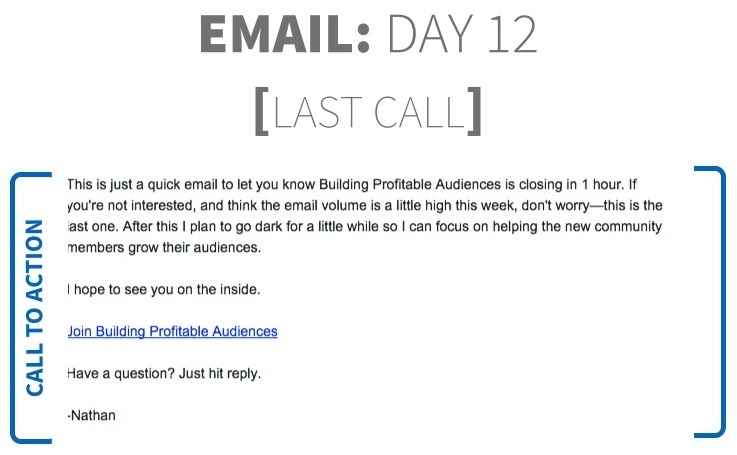
There is limited time — only 1 hour left — before readers can no longer buy the course.
Nathan communicates this very succinctly and gives them one clear call to action.
Click. The. Link.
Nathan used this sequence of emails to launch a new product to a specific segment of his list. But there’s no reason you couldn’t write up a similar automated email sequence that does the same thing for one of your existing products.
You can use automation to send that sequence of emails to any subscriber who has expressed enough interest to be qualified for that product.
That might mean they’ve purchased one of your lower-priced products. Or that they downloaded a particular lead magnet. Or maybe you want everyone who signs up for your list to automatically receive the email sequence.
There are obviously lots of variables that depend on your unique audience and product. But your basic action steps for this email marketing funnel will be:
- Identify your target audience: the people on your email who would be interested in the product you want to sell
- Write the email sequence that sells them on your product
- Send the email sequence to those people
- Automate the process so that any subscriber who expresses enough interest automatically receives the email sequence
Expected Results:
Nathan had 18,000 people on his email list when he implemented this funnel and did $16,000 in sales.
But remember only the 1,200 subscribers who had already purchased his book actually went into the funnel, for a conversion rate of around 2%.
Obviously, results will vary depending on a number of factors like:
- The quality of your relationship with your subscribers
- The price of your product / overall offer
- The effectiveness of your emails
Notice that I didn’t include “size of your list” in those factors. That’s because we’ve seen people get huge results from small lists again and again. You don’t need a 5-figure list to have a 5-figure launch.
If you create a product your subscribers want and you have a good relationship with them, you can easily hit a conversion rate of 2% or higher. You can always ticker with your subject lines and experiment to get higher open rates, etc., but that comes after your funnel is in place.

Get it Free
FREE Bonus: Sales funnels are useless without traffic. That’s why I created a 15-minute training to show you the #1 strategy for bringing 6-figure traffic to any funnel! Click the button to unlock your 24-hour pass to the training now.
Template 4: Paid Ads Funnel
Degree of Difficulty: 5 out of 5
Traffic Source: Paid traffic channel like Facebook or Google
The coolest thing about Facebook ads is how easy they make getting your business/product in front of people who are already in the Awareness stage of the funnel. With Facebook, you can easily target:
- People who have recently visited your website
- People who are already on your email list
- People who “like” your page on Facebook (if you have a Facebook page for your business/product)
You can also target people who may not be aware of your business, but who are aware of either your competitors or the problem your product solves:
- Lookalike audiences—these are audiences of people who Facebook thinks “look like” the people already coming to your website or subscribing to your email list. Basically, they’re people with similar interests and habits to the people who already like you. Creepy, right? But powerful!
- Interest-based audiences—for example, if you’re selling email marketing software, you could target people who have expressed interest in things like email marketing, MailChimp, Infusionsoft, etc.
WARNING: Before you go any further, it’s important that I tell you something about Facebook ads…
If you do not have an email list of at least 10,000 subscribers, I do not recommend running Facebook ads.
At Growth Tools, we didn’t start running Facebook ads regularly until we had over 100,000 email subscribers.
Trying to mess with complicated online marketing strategies too early in your business is a recipe for failure. We see small business owners lose thousands of dollars every year on Facebook ads because they jumped in too soon.
That said, if you’re at a place where you feel comfortable investing a little more money and you have the time to be patient, proceed.
/end rant
Like I said, you can get crazy complicated with Facebook ad funnels. But let’s start with the most basic ad funnel template possible. It’s from an optimization company called Crazy Egg, and it starts with this ad:
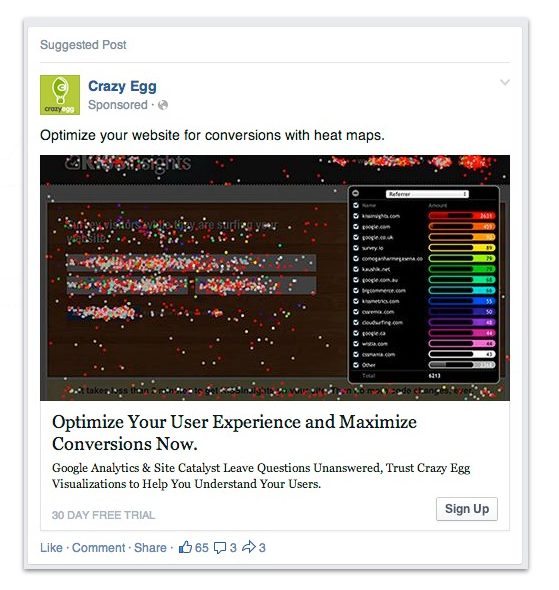
When you click on that ad, you’re sent to a simple signup page for a free trial:
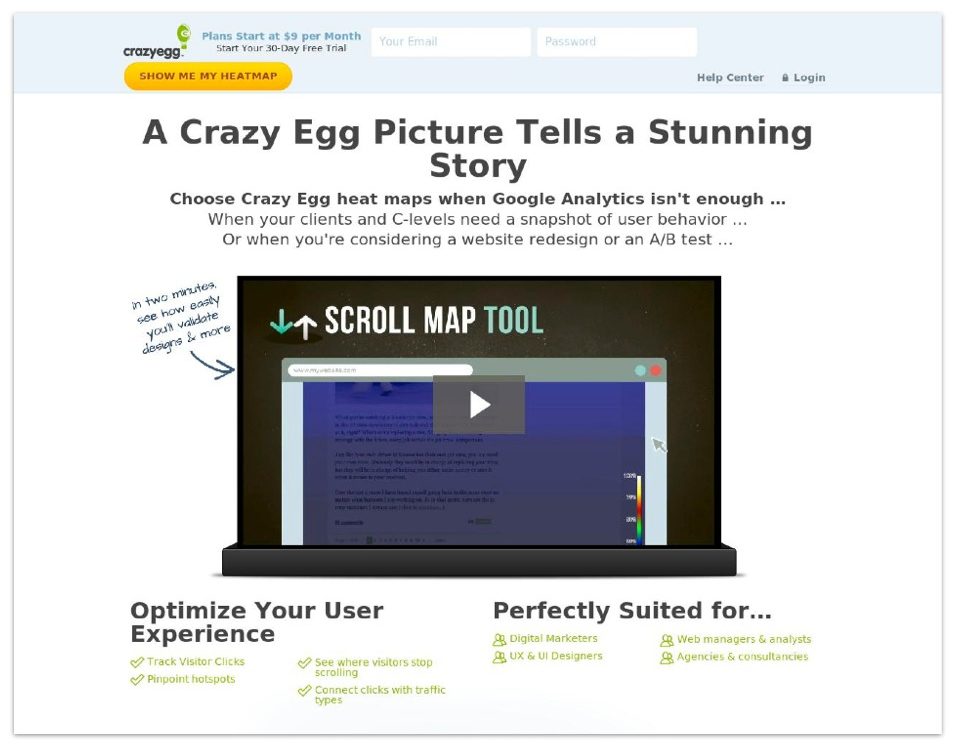
From there, people either start a free trial or leave the page. Simple, right?
Quick and easy funnels like this can work well for very warm traffic, like people who are on your email list or have visited your site recently.
They’re already in the Interest stage, so it doesn’t take as much work to convert them as it would to convert people who aren’t even aware of you before they see an ad.
But what about people who are less aware? For that, let’s take a look at a much more complex Facebook ad funnel from Jeff Walker, who created an incredibly successful online course called Product Launch Formula.
This marketing funnel is designed to sell a $197 product…but you won’t be able to tell that at first. It starts with this ad:
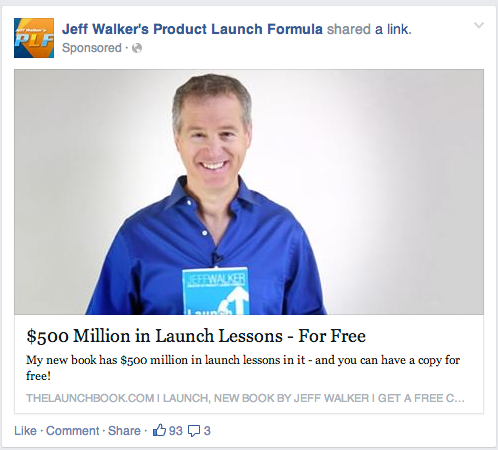
Even though Jeff’s funnel is ultimately going to try selling you on a $197 product, it starts by selling you on something much cheaper: a $5.99 book.
The sole purpose of the ad is to drive traffic to his landing page for that book.
By using Facebook ads, he is able to send highly targeted traffic there (even if that traffic might not be aware of who Jeff is yet).
For example, he could target everyone who follows Michael Hyatt.
Why Michael Hyatt? Because he just ran a series of webinars and launched a WordPress theme and the #1 goal of those products was to build your platform so you could launch a profitable business.
This means Michael’s readers have launching on their mind. That’s good for Jeff because his book is on that exact subject.
Targeted Traffic = Good.
Once you click on the Facebook ad, you are taken to the main landing page.
The landing page is a big deal. Here’s Jeff’s:
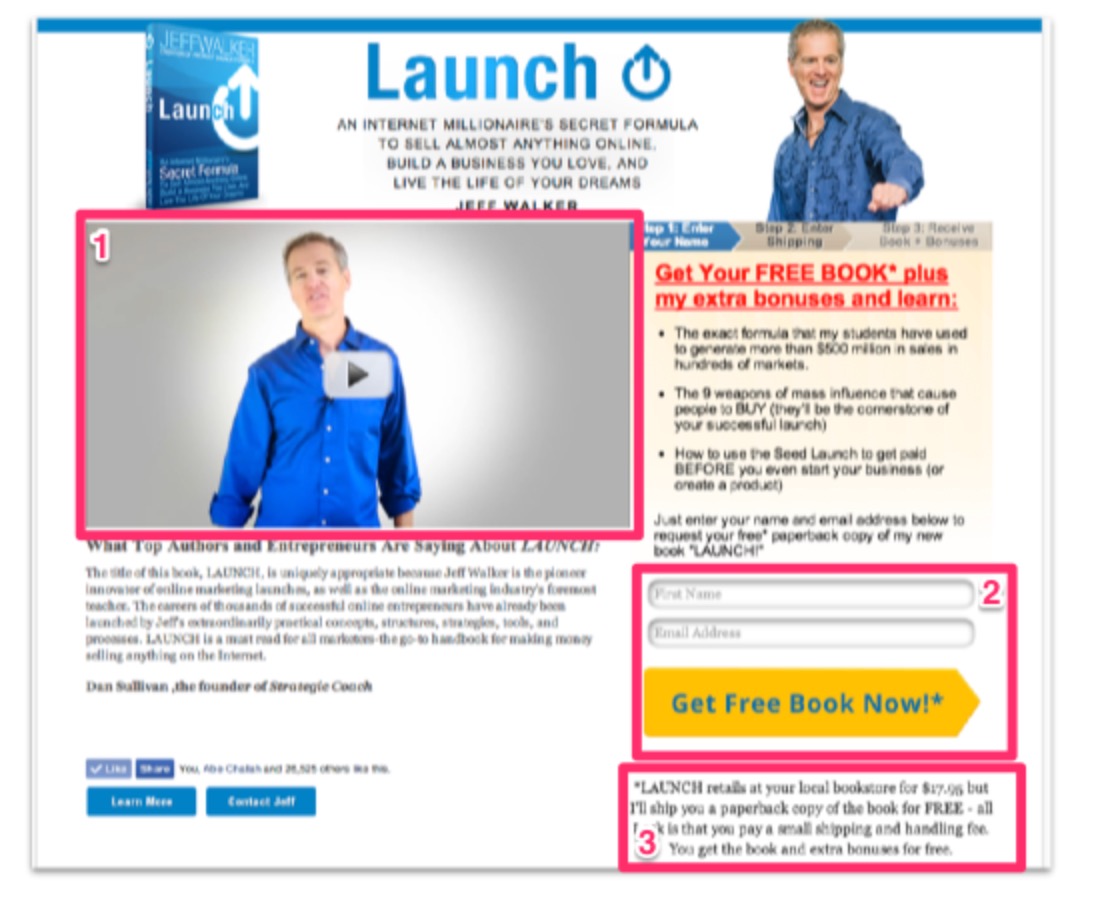
The traffic sent to this page has to convert to the next page. For every person that visits and doesn’t make it to the next page, he loses money—which is exactly why I recommend being at a more advanced stage of your business before trying too much with Facebook ads.
Anyway, that’s the mission of this page: Get all visitors to the next page.
There are three key elements that make this landing page work.
1. Video: Jeff uses a short video to tell you exactly what is in the book. He does a good job of being concise and laying out the results you can see from implementing his methods.
Video tends to convert a lower overall % of traffic on these types of landing pages but the quality of the people that do convert is higher.
2. Opt-in Box: The central element of the page is this box. The button color contrasts with the rest of the page and immediately attracts your eyes. This is the singular call to action on the page and is designed to get you to immediately take action.
3. Value: Just below the opt-in box is one sentence that reminds you that the book, once officially released, will cost $17.99 but you are getting it for $5.99 (shipping cost). This reinforces your original intent of coming to the page and gives you that last little kick in the butt to fill out the form.
Once you fill out this form you are taken to the order confirmation page.
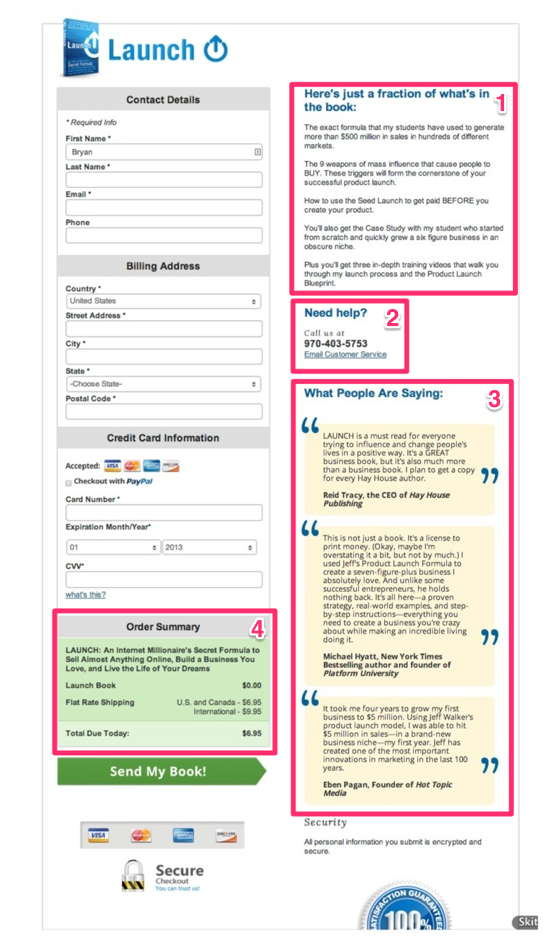
At the order form, we’ve reached the Decision stage of the funnel.
This is where the sale is made and money is exchanged OR you lose them altogether.
Every element of this page is intended to re-assure and drive home the key selling points made in the Facebook ad and on the landing page.
Mission: Make them feel confident you are legit and remind them why they are here.
There are 4 key elements that make this happen.
1. Breakdown: In the upper right-hand corner is a quick recap of what is covered in the book. This helps to jog my memory of why I wanted the book and clicked that ad in the first place.
2. Contact Information: If I have made it this far it means I am serious about buying. However, I might still have reservations about who Jeff is and his legitimacy.
Does he know what he is talking about?
Is he some weirdo fly by night guy?
By providing an email address and phone number positions him as being more contactable and his creep factor decreases even further.
I probably won’t be calling to chat before I order, but just having that option makes me feel better.
3. Testimonials: The most powerful way to sell anything is word of mouth. By providing testimonials from other experts in the industry, Jeff uses word of mouth to remove any remaining doubts his visitors might have had.
At the end of the day, I might not know Jeff or I might get a weird vibe from him, but if I see that Michael Hyatt trusts him that immediately gives Jeff legitimacy. Social proof is powerful.
Trust in Michael → Trust in Jeff.
4. Order Summary: It is important that Jeff not make his visitors feel like he is making money off of shipping and that he is legitimately giving them a gift. By plainly showing the price breakdown this helps to reinforce that message.
If, by the time I get to this page, I feel like he has tricked me into giving him $5.99 for a ‘FREE’ book and that shipping isn’t a legitimate cost, then he loses my trust and the order.
Once the “Send my Book” button is pressed you are taken to the Thank You page.
Pay close attention to what is going on in this next step. That is where the magic is happening.
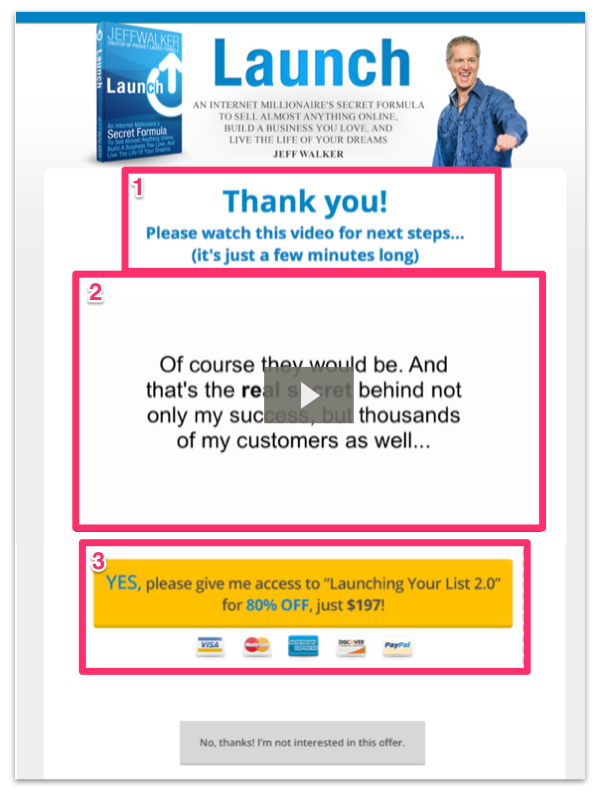
Quick Recap:
First, Jeff showed me a Facebook ad by precisely targeting my interests and likes.
Second, when I clicked on the ad I landed on a page whose sole purpose was to tell me about the book and get me to the next page.
Third, the order form reaffirmed the reason I originally clicked on the ad and made me feel good about Jeff being a legit dude. I entered my information and ordered the book.
After ordering the book I was sent to a generic looking Thank You page. But it is far from your normal everyday Thank You page.
The purpose of this page isn’t to tell me “thank you.” It is specifically designed to get me to buy a related product.
But it does so without losing the trust of people who are not interested by not even showing them the offer.
Here are the core elements of how it works:
1. “Thank You” Message: By asking me to “watch this video for the next steps” he is able to keep my attention because he tied in the video (which contains his next offer) to the previous purchase.
When I first saw this note I immediately thought, “Well I need to watch this so I don’t miss any important details about the book.”
2. Video: The video is related to the book but it’s purpose is to tell me about another product. It’s main goal is to sell a related course called “Launching Your List 2.0” which costs $197. The video briefly talks about the book and how one of the key elements to any launch is building your email list.
Then he spend 90 seconds telling me about the course.
For anyone that leaves the page before the end of the video, that is all they see. A quick “Thank You” and a video. No offer.
However, if you stick around and watch the video all of the way through a button with an offer appears right below the video.
3. Call to Action: The yellow button that you see is setup to keep people who are not interested from feeling like he is “just trying to sell them something else.”
By waiting to show the button until the very end he does not burn any good will with his less interested viewers and builds anticipation and urgency for those that are interested.
For those that do see it and are interested he’s made the ordering process extremely easy. The only thing they need to do to order is click the button.
…they don’t have to enter payment information.
…they aren’t forwarded to another order confirmation page.
…there isn’t a dedicated sales page for the course that they have to click through.
Just the video and a button, that is it. Super simple.
All of their order information is carried over from the previous page. So, once the button is clicked your $197 course upsell is immediately processed.
VERY smooth and friction free. So much so that it is almost shocking when you go through it yourself.
That process is called a “one click upsell.”
From there, you’re sent to the final Thank You page.

The final Thank You page doesn’t overtly sell anything else, but it does set up the last piece of the sales funnel.
1. Bonuses: The bonuses mentioned on the original sales page and in this thank you page are actually a series of emails to upsell Jeff’s flagship product “Product Launch Formula.”
As a part of his launch sequence for Product Launch Formula, he has put together a series of three videos that educates you on the foundational principles and gives you a ton of free information.
Your bonus for ordering the book are these three videos.
At the end of three videos you will get an offer for the full course which costs $2,000.
Smart right?
When you buy his book you are upsold a $197 product then put into an email sequence to be upsold a $2,000 product within the next 10 days.
2. Sharing: Lastly, you are encouraged to share the book launch page with your friends. This is the one area that Jeff could have done a better job on. By including click to tweet links his share rate on this page would have increased greatly. He got a little lazy here at the end.
However, don’t let that overshadow the greater strategy here.
Not going to lie here, this is an advanced strategy. Which is why most people don’t use it. And why I don’t recommend everyone try to use it. And why I rated it 5 out of 5 on the difficulty scale!
But if your business is far enough along where you feel comfortable spending money on Facebook ads (and potentially losing it while you experiment to figure out what works) it can work great.
- Start with figuring out the products you’ll include. If you have multiple products, link them together like Jeff did.
- Only have one product? Create a $5.99 version and link it to your flagship product.
- Create your Facebook ad and landing pages. For a detailed look at how to do this, check out the live 14-day Facebook ad experiment we ran.
- The implementation varies a good bit based on what shopping cart you use to sell your products.
Expected Results:
I highly recommend you start by testing a paid ads funnel more similar to Crazy Egg’s than Jeff’s. Two reasons:
- It’s way easier to convert warm traffic.
- It’s also way less complicated.
One of our earliest wins with paid ads came when we implemented a simple funnel to warm traffic during a product launch. Here’s how it worked:
- We put our email list through an email sequence for our flagship course at the time, Get 10k Subs.
- The emails sent them to a sales page for the course.
- We showed a Facebook ad for the course to people who visited the sales page but didn’t buy (at a cost of a little over $500).
The results? 33 of the people who clicked on the ad bought the course, for a total of $46,464 in sales.
Get your feet wet with a simple, low-risk funnel like that. Once you’re successful, dive into the nerdier stuff.
So far, every successful sales funnel we’ve looked at has required generating your own traffic through methods like content marketing, SEO, paid ads, external links, word of mouth, etc.
Generating your own steady traffic can take months—if not years sometimes—so I wanted to include a few templates that allow you to use other people’s audiences in order to fill your sales funnel with qualified leads.
While these strategies are sometimes quicker than figuring out how to generate traffic yourself, don’t be fooled into thinking that makes them easy. They still require a lot of time and energy, but the payoff can be big.
Template 5: Partner Webinar Sales Funnel
Difficulty: 4 out of 5
Traffic Source: A partner’s audience
You’re already probably familiar with regular webinars:
- A business creates an online presentation that teaches their audience something useful.
- At the end, they offer everyone who attends a special deal on their product.
- They get customers!
Webinars are an incredibly powerful way to sell products. We use them in every launch and many of the funnels we have at Videofruit.
But…what if you don’t have an audience to invite to your webinar?
Then you run a partner webinar. Here’s how they work:
1. Find someone with an audience of people who might buy your product.

2. Ask them to do a webinar with you.

3. On the webinar, teach stuff related to the topic of your product.

4. At the end of the webinar, pitch your product.

5. Split the profits with your partner.
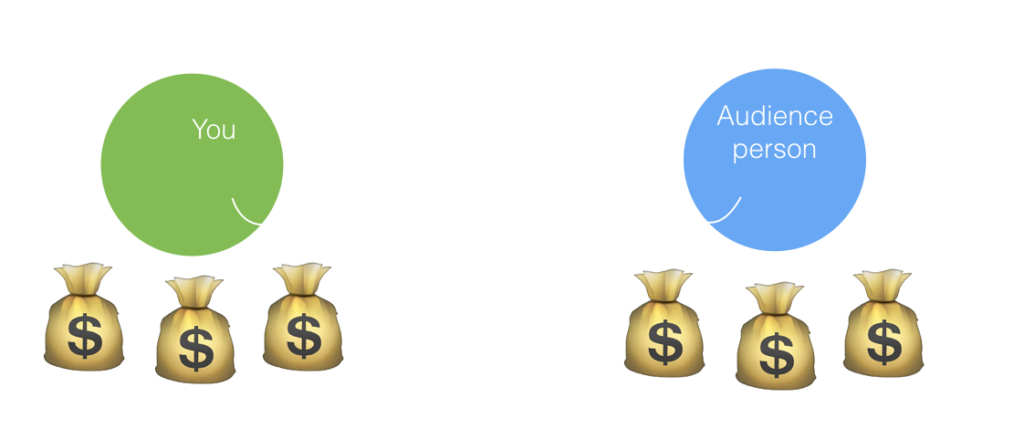
It’s simple and works like a champ.
In the first five weeks of 2017 we hosted 3 partner webinars that generated 4,500 new emails subscribers and $65,000 in sales.
(Update: You can actually do a version of this without profit-sharing. And still make your partner thrilled to share you with their audience. Want to know how? Check out our new guide to partnership marketing.)
You don’t have to have an email list and you don’t have to be a big name. All you have to do is find someone with a relevant audience, ask them to partner with you, and create a funnel that ensures you convert as many people as possible into customers.
I’ve already written extensively on how to actually find partners, do some outreach, and create a great webinar, so be sure to check out this post if you want those details.
Here, I’m going to focus on the funnel.
Once you’ve gotten a partner to agree to host the webinar, you have two main pieces of the funnel to focus on:
- The emails your partner will send to get people to show up to the webinar
- The emails you’ll send after the webinar that get people to buy your product
Here’s a visual overview:
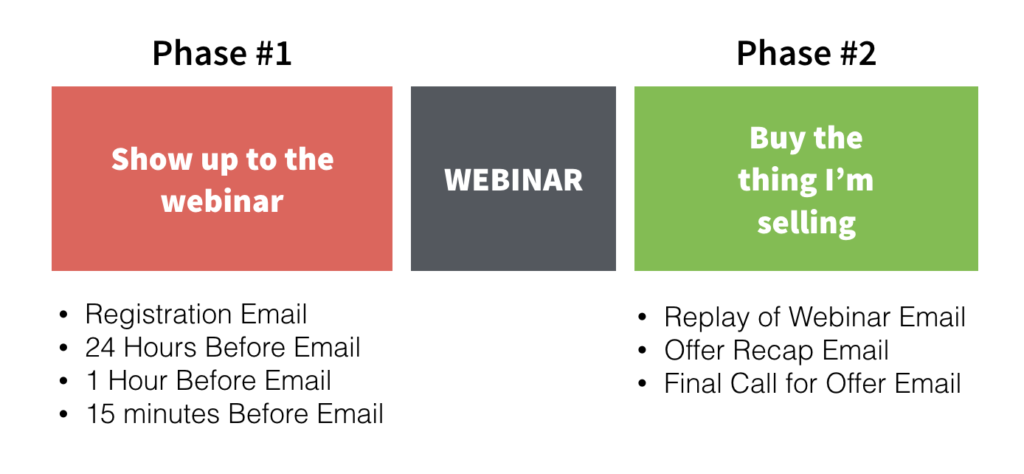
The first email (the registration email) is the most important one. It needs to not only sell your partner’s audience on the content of the webinar, but also sell them on who you are and why they should listen to you.
Recently, we did a partner webinar with Tim Grahl. Here’s the copy from the first email that went out:
If I said you had 24 hours to write and launch a book, how many copies do you think you could sell?
Last year, my buddy Bryan actually did this—even though he had never written or published a book before.
Madness, right?
Yet within 48 hours of launching a book he only spent a single day creating, he’d already sold 167 copies and made $6,635.
What was his secret?
I’ll start by telling you what it wasn’t:
- He didn’t have any connections in the publishing world
- He didn’t spend a bunch of money on Facebook ads (in fact, he didn’t spend a dime on marketing)
- He didn’t sell one bulk order to some company his friend works at
All he did was send a single email to a small list of 353 people he knew were interested in his book’s topic.
I’ve said many times that building your email list should be every author’s #1 goal for marketing their books, and this is exactly why I do it.
Want to learn how to build a list of people who can’t wait to buy your book? Do two things:
- Click here to see the book Bryan wrote and sold to over 100 people in 24 hours (it started as a Google doc).
- Show up to the free live webinar we’re hosting together next week (you’ll be instantly registered when you click the link above) called How to successfully write and launch your book in 48 hours.
Whether you want to self-publish or traditionally publish, having your own email list of people hungry for your book’s topic is the surest way to have a successful launch.
If Bryan could achieve these results for a book he wrote in a single day (click to check it out and be instantly registered for our list-building webinar), imagine what you could achieve for yours.
– Tim
Notice how the email not only tells people about the webinar, but also:
- Introduces who I am and how I can help Tim’s audience
- Gives them something cool they can access right away
- Makes it as simple as possible to register for the webinar (we set up one-click registration using a free tool called One Click—it converts way higher than sending people to a registration page)
Follow this same pattern for your second reminder email.
The third and fourth reminder emails can be straight and to the point. Here’s what the final reminder email Tim sent said:
Quick reminder: Bryan Harris and I are putting on a free workshop TODAY at 3pm CT (4pm ET | 1pm PT) that shows you exactly how to build an email list of readers who are primed to buy your book.
We’d love to see you there—just click here and you’ll be instantly registered.
Here’s what Bryan’s going to show you:
- The 6 best strategies authors can use to grow their email lists (these are things that are actually working right now, not the same old boring ones everyone always talks about)
- How to go from 0 to 1,000 subscribers and start averaging 50 new subscribers per day by the end of the year
- Get access to proven templates and email copy you can use to crush your book launch when the time comes
- Plus, Bryan and I will have a live Q&A at the end where you can ask us anything about growing your email list and turning subscribers into book sales
We’re not just showing up to talk at you—we want to hear about YOUR specific situation and challenges so we can help you build your audience, sell more books, and launch with confidence.
Sound good? Then make sure you’re primed and ready to go at 3pm CT (4pm ET | 1pm PT)!
Click here to save your spot and instantly register.
An email list is the #1 most critical tool you need to grow your following as an author. Taking an hour to learn how to build one will be one of the most valuable investments you make in yourself and your career.
Make that investment in yourself today and join us at 3pm CT (4pm ET | 1pm PT). It’s totally free.
I’ll see you there!
Tim
A good reminder email includes:
- All the relevant calendar/scheduling info
- An early call to action, so they don’t have to scroll if they want to register
- Bullet points on the benefits of attending the webinar
- A few more calls to action
Now for phase 2 of the partner webinar funnel—post-webinar emails.
Even though you’ll pitch your product on the webinar, you’ll want to follow up with everyone who attended (and didn’t attend) with additional calls to action. After all, not everyone is going to buy on the webinar, and some won’t even attend long enough to see your pitch.
Below, I’ve included screenshots of the four post-webinar emails ConvertKit sent after a recent partner webinar I did with them. Each email is designed to get you to buy the special offer they presented on the webinar.
(And in case you’re wondering if this partner webinar funnel has been successful for them…it’s the #1 strategy that helped them grow from making a few thousand dollars a month to over $6 million in annual recurring revenue.)
On to the emails…
Email #1: Thank You / Replay

Notes: This email includes a quick and easy link to the replay, reminds those who attended about the offer, and lets those who didn’t attend know they can get a special deal.
Yes, you can use marketing automation to get fancy and send an email specifically to those who didn’t attend and a different version of the email to those who did attend, but this just goes to show that you don’t have to make things as complex as possible in order to get great results.
Email #2: The Most Important Lesson

Notes: This email contains a lot of teaching / recapping of some of the most important things taught on the webinar. This allows you to deliver value and give those who didn’t attend a taste of the content before reminding them about the exclusive offer.
Email #3: Show Them It’s Possible

Notes: I call Email #3 the “Show Them It’s Possible” email because that’s exactly what it does—it lets people know that they really can achieve the thing they want (in this case, growing an audience), and then shows them how your product makes doing that even easier.
This kind of email can help reluctant buyers overcome limiting beliefs and objections.
Email #4: The Final Pitch
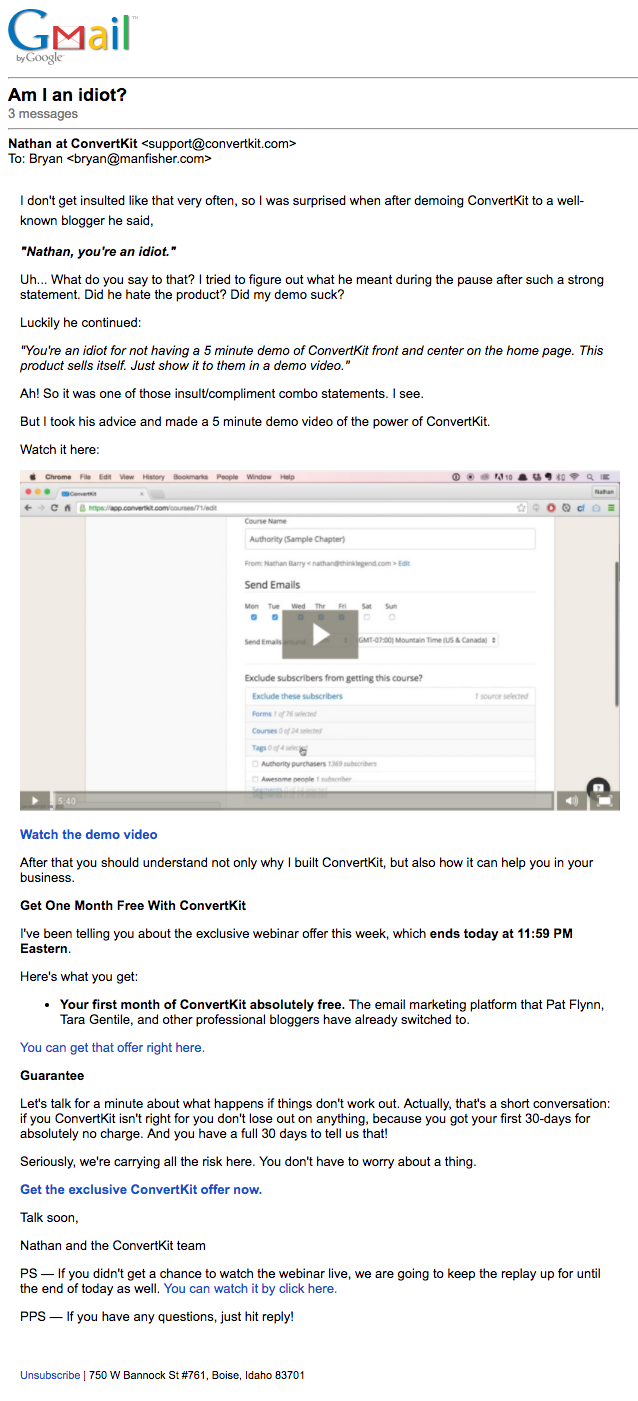
Notes: When it comes time to send the final email, teaching time is over. In this email, you just want to be crystal clear about the value and urgency of the offer.
- Copy my strategies for finding and securing the perfect partner
- Create your webinar and compelling offer (again, the above link can help you with that)
- Write a series of emails for your partner to send to their audience before the webinar
- Use One Click to enable one-click registration in your emails
- Write a series of post-webinar emails that sell registrants on your offer
Expected Results:
Partner webinar results will depend on a lot of variables. We’ve done a ton over the past few years and they tend to get the best results when we focus on:
- Making sure the product being offered can genuinely help the partner’s audience.
- Choosing an angle for the webinar that is super specific to the audience’s needs/problems.
- Looking for long-term wins — sure, it’s great to get a lot of immediate sales, but don’t discount the opportunity to add a TON of people to your list. We’ve added tens of thousands of subscribers via partner webinars, and that’s added up to a lot of long-term wins.
To give you an idea, here are some of the results from that webinar we did with Tim Grahl:
- New subscribers added: 1,400
- Sales: $16,653
- Conversion rate of webinar and replay: 1.6%
My takeaways: Given the number of registrants, Tim’s audience was clearly interested in the topic of email list-building. We could probably improve the webinar conversion rate by tweaking the offer in the future to target that buyer persona better.
Template 6: Virtual Summit Sales Funnel
Degree of Difficulty: 5 out of 5
Traffic Source: Multiple partners’ audiences
Partner webinars sounded pretty cool, right?
A virtual summit is basically a partner webinar times 10. It’s a big free online event where you interview a dozen or so experts in a particular topic and they all promote it to their audience.
So while it’s 10 times the work of organizing one partner webinar, it can also produce 10 times the results.
Take Chandler Bolt, for example.
He created a virtual summit around the topic of self-publishing that generated 25,000 email subscribers and $350,000 in sales in a 10-day period.
Crazy, right? I almost couldn’t believe it at first. But I’ve since seen tons of awesome people implement this strategy and get incredible results.
Like Michael Hyatt…
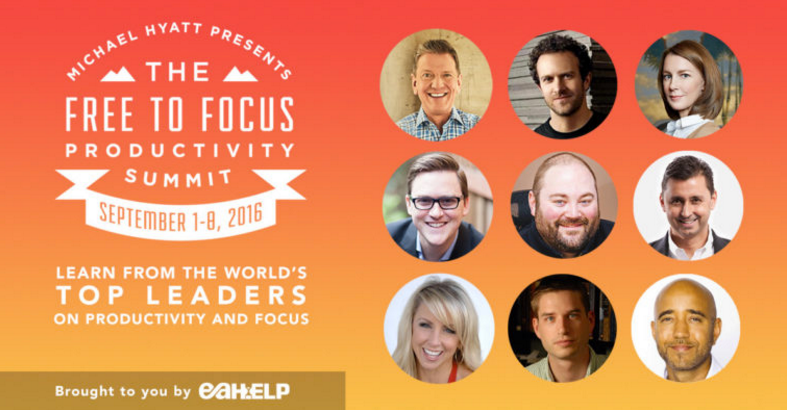
The email marketing software company Drip…
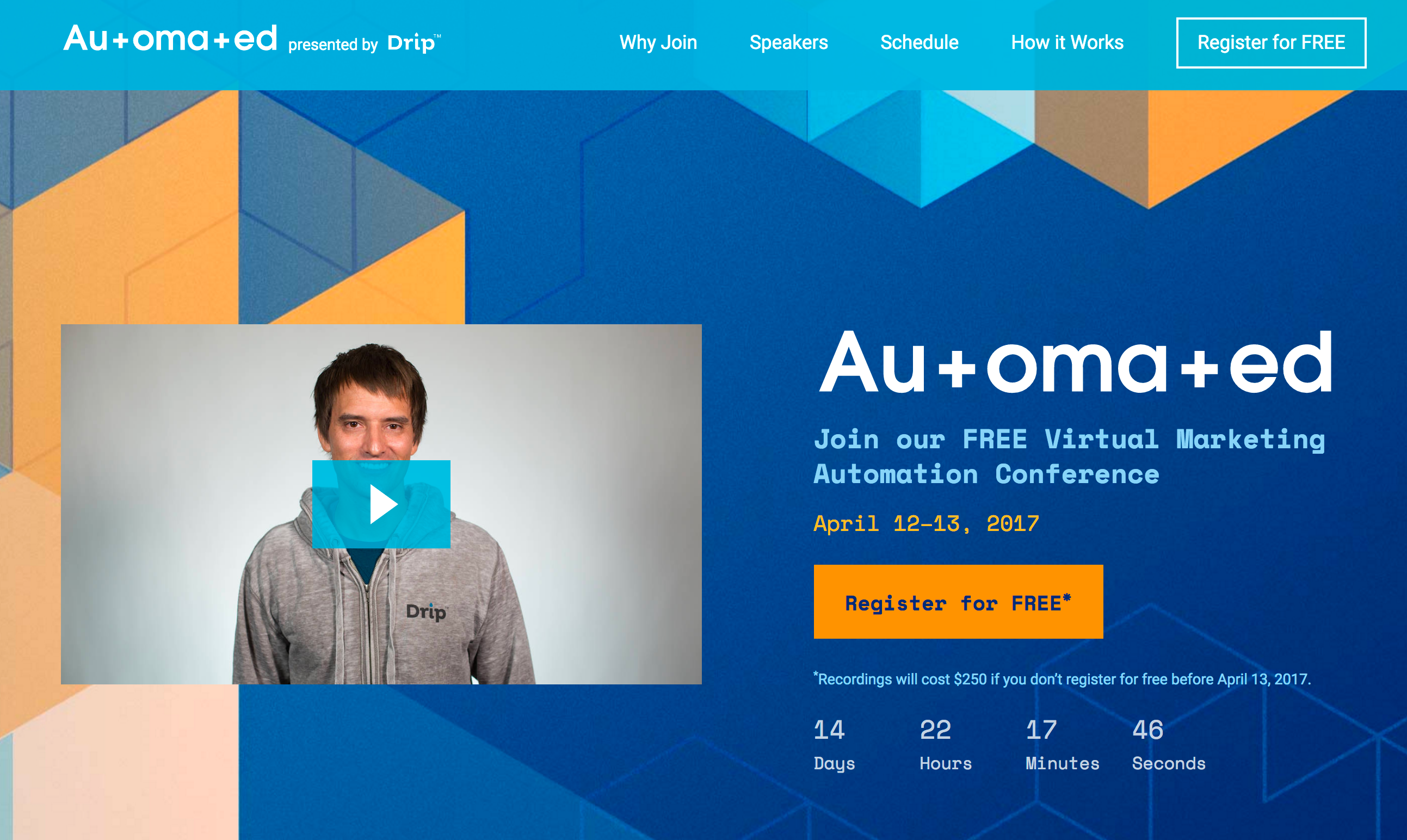
Steph Gaudreau…
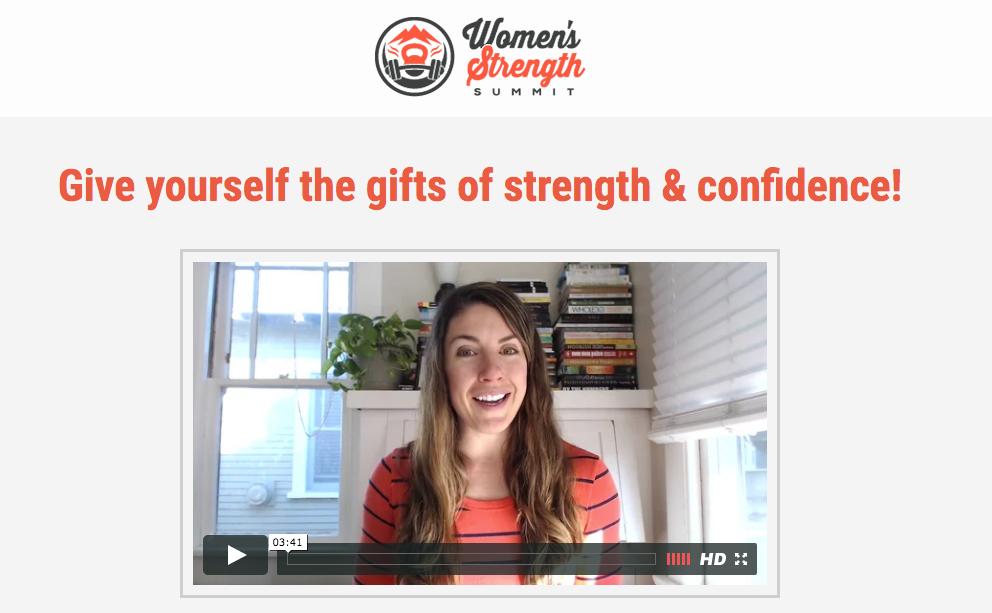
And of course the guy I mentioned before, Chandler Bolt…
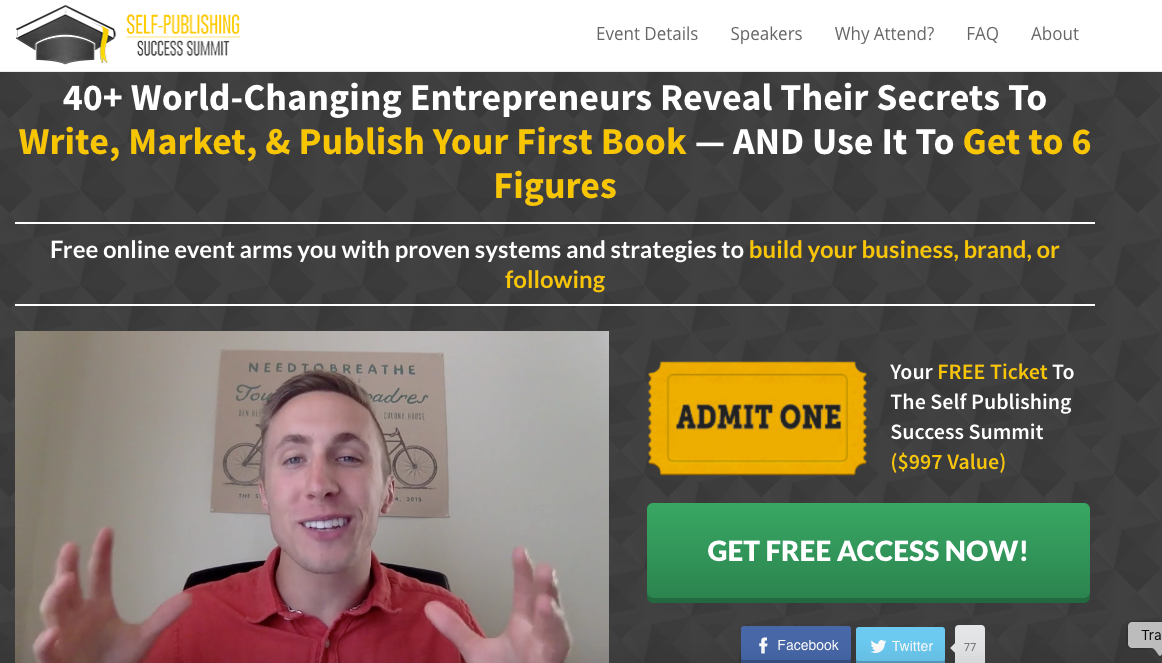
Here’s the basic overview of how virtual summits work:
- You pick a topic for the summit (something related to your business).
- You invite a handful of people to speak at the summit.
- You interview each speaker ahead of time.
- You ask each speaker to promote the event.
- 20-40% of the speakers agree to promote it.
- You release the interviews with each speaker over a 10-day period.
- Each speaker sends new subscribers and customers to your list when they promote it.
- You promote products to everyone who registers for the summit and split the revenue 50/50 with the speakers.
I wrote a full breakdown of Chandler’s strategy here (from picking your topic, to recruiting partners, to scheduling everything, etc.), but I want to give you an overview of the funnel template here so you can see how it works.
Let’s start with the first part of the funnel—the landing page.
Part 1: The Landing Page
Your landing page has a pretty straightforward job: get people to sign up to attend your free virtual summit.
I recommend using a tool like Leadpages to create yours.
Here’s a better look at Chandler’s page:
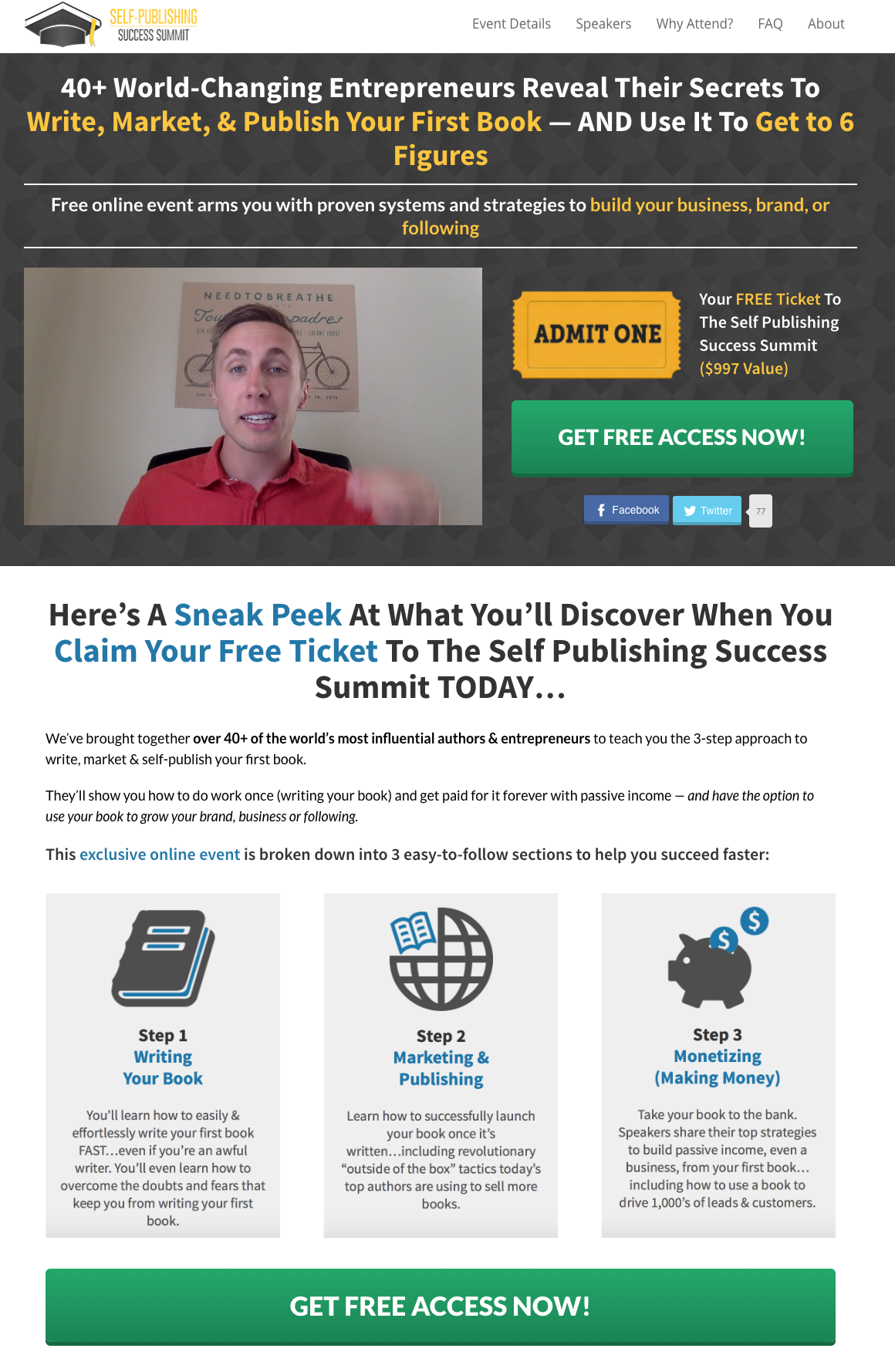
Make sure to include things like:
- Summit’s name and dates
- Summit’s theme/benefits (what attendees will walk away with)
- Top speakers (you can add these as you book them)
- Video explaining the summit
- Compelling Images that show off what attendees will learn
- FAQs
- A sign-up form integrated with your email service provider
This is the page you’ll ask everyone you interview to promote to their audience. You’ll also promote it to your list if you have one.
Part 2: Thank You / Sales Page
The best way to get instant ROI from a virtual summit is to package recordings of every session into an “all-access pass” product and offer it to everyone who registers.
And the best place to do that is the page they see immediately after registering—the thank you page.
The person who visits this page is obviously already interested in your topic, so this is a perfect time to upsell them on your all-access pass.
You can also choose to have a regular thank-you page here, which includes information on the summit and what they should do next. (However, you’re probably really missing out if you choose this!).
Here’s a look at Chandler’s page:
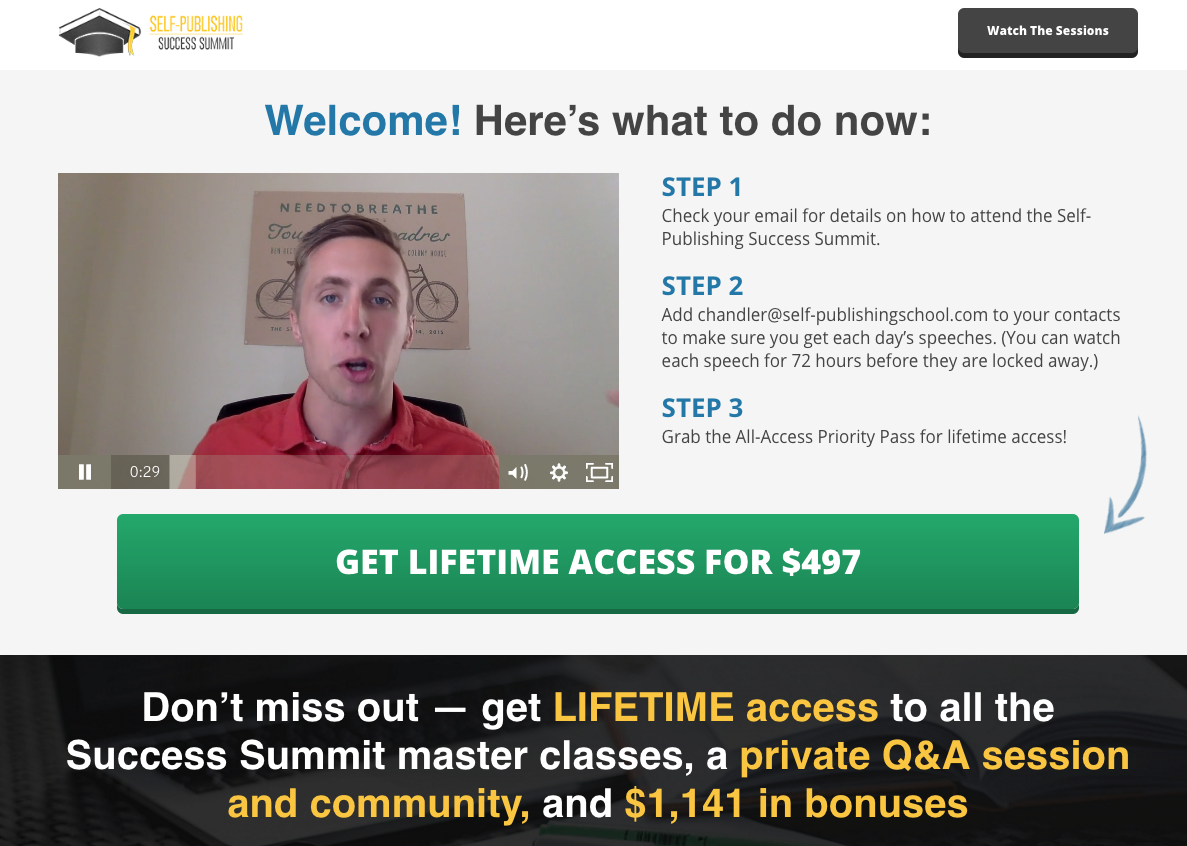
You can see the entire page (yep, there’s more!) here.
Part 3: Emails
There are three types of emails you need to send:
- Emails that get people to register to attend the summit
- Emails that remind registrants to actually attend
- Emails that sell your all-access pass product
First, you’ll want to promote the summit to your own email list multiple times. Here are the emails you’ll send:
- During the first week of the month: Send an email announcement about your summit to your entire email subscriber list.
- One week before your summit begins: Send an email reminder to register to your entire list.
- Day before summit begins: Send an email letting your list know that the summit starts tomorrow.
- Day of the summit: Send an email highlighting your kick-off speech and letting them know the summit has begun.
- Two days after summit starts: Send an “It’s not too late to join” email to your subscriber list.
Note: In addition to emails… you may also want to send text messages to let your audience know about important events/dates. We created a FREE tool… Remind Them to help you collect phone numbers and send text messages. Check it out.
It’s also a good idea to write up generic versions of these emails you can give to your partners so they can use them as templates to promote the summit to their list too. The more work you do for them, the more likely they’ll promote it to their audience (your potential customers).
Once the summit starts, be sure to send an email every day to registrants that covers the sessions happening that day. Here’s an example from Chandler:
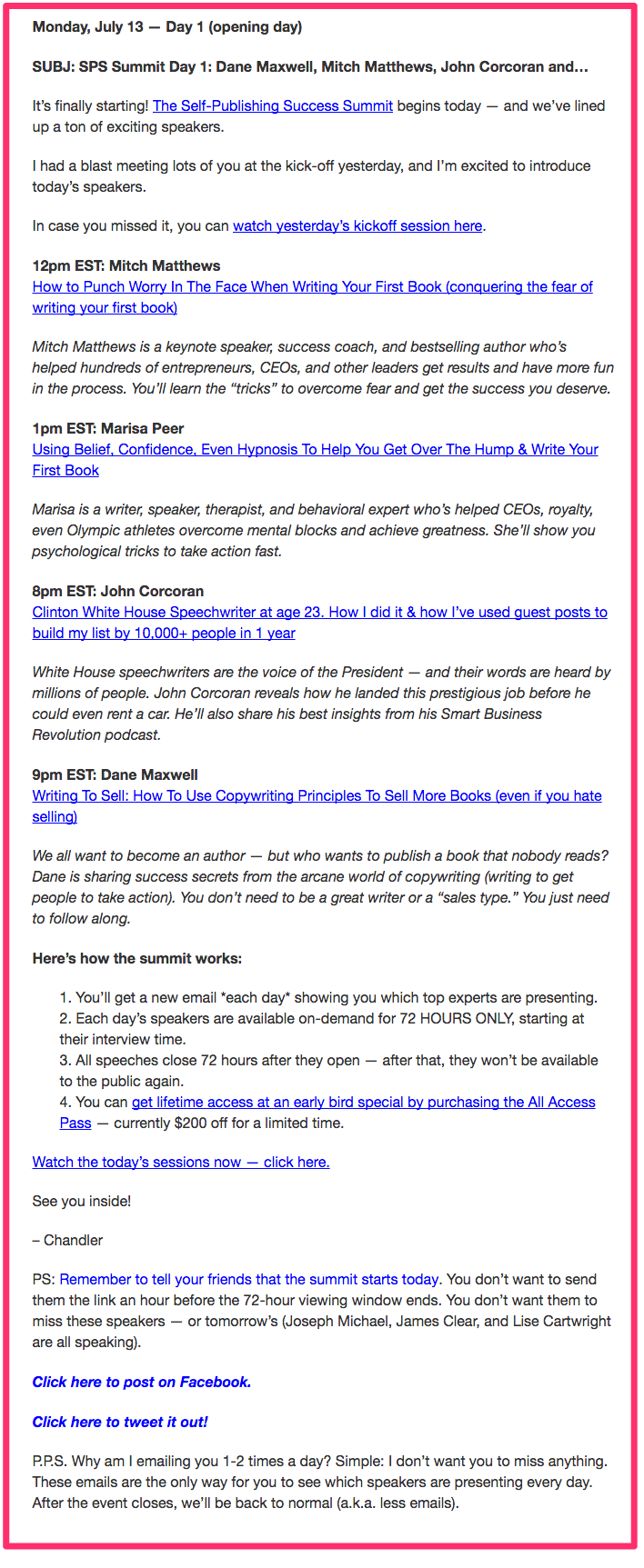
And finally, be sure to promote your all-access pass via email as well. Chandler recommends increasing the price as your summit goes on. That will create urgency for people to buy instead of waiting and forgetting.
Here are the prices Chandler recommends using, and when to email about each one:
- Early bird All-Access Pass Price (until the summit begins): $97
- All-Access Pass Price (change starting day of the summit): $197
- Final All-Access Pass Price (change three days into summit): $497
As you can see, there are lots of moving parts to this funnel. It’s a ton of work, but it can pay off in a huge way in a relatively small amount of time.
- Plan your summit and secure partners using the in-depth guide I created with Chandler here.
- Create your registration and thank you / sales page
- Write your registration emails
- Write your attendance reminder emails
- Write your all-access pass sales emails
Expected Results:
Your results for a virtual summit will depend almost entirely on the quality of the partners you recruit and your execution at coordinating everything. Like I said, it’s complicated and there are tons of moving parts.
BUT…when it goes right, it often goes VERY right.
Chandler’s virtual summit was definitely in that camp. He generated:
- 25,000 new subscribers
- $350,000 in sales (split 50/50 with partners)
Not bad, right? 🙂
What Sales Funnel Will You Create?
Woohoo! You made it to the end!
Pat yourself on the back and take a breath.
Now comes the fun part—actually picking a sales funnel to implement in your business.
My best advice? Don’t. Over. Complicate. This.
Start with whichever one makes the most sense given your traffic sources, time, and resources. Again, this is a learning process.
Questions? Want us to add more funnel templates to this post? Leave a comment below and let us know what else you’d like to see.

Get it Free
FREE Bonus: Sales funnels are useless without traffic. That’s why I created a 15-minute training to show you the #1 strategy for bringing 6-figure traffic to any funnel! Click the button to unlock your 24-hour pass to the training now.


